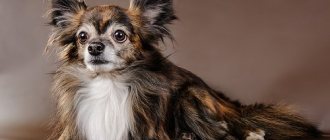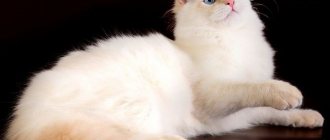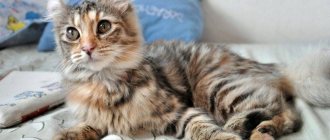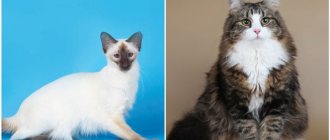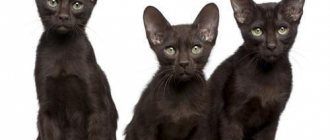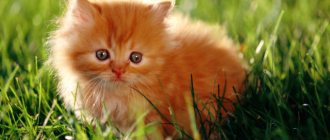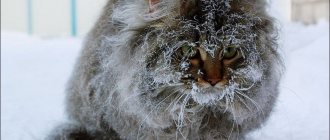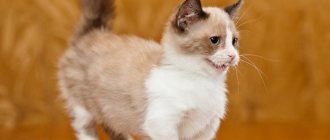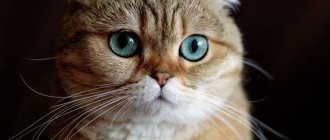From the history of long-haired cats
Long-haired cat breeds first appeared on the European continent approximately in the mid-16th century. They were first learned about in Italy. Representatives of these breeds gained wide popularity after Cardinal Richelieu himself got himself a long-haired cat. For a long time, these animals, due to their rarity and high cost, were the privilege of only noble and wealthy people.
Until now, long-haired cats are extremely popular not only because of their attractive appearance, but also because they are rightly considered the kindest, most affectionate, tame and flexible. These pets become attached more to the owner than to the house, unlike most other cats.
Third place – long-haired Burmilla
Long-haired Burmilla
The long-haired Burmilla appeared as a result of the mating of a Burmese cat and a chinchilla-colored Persian in the 80s of the last century. The breed was first recognized internationally in 1994. The long coat is silky and shiny. The color can be shaded, smoked or solid brown, chocolate, cream or other colors. The undercoat is usually silver in color. The silky coat rarely gets tangled and therefore does not cause any particular difficulties in care.
Interesting: The most popular conditionally edible mushrooms: list, names, photos and videos
List of semi-longhair cat breeds
The list of semi-longhaired cats includes many representatives of ancient breeds, but at the same time there are also “newcomers” that were bred over the past 50 years.
American breeders are leaders in the field of creating new types of cats. They are constantly experimenting to get as many new colors as possible, and are also very actively working with mutation of forms.
Turkish van
Despite the fact that a wide audience learned about this handsome man only in the middle of the last century, his history began more than a thousand years ago. The cat is recognized as indigenous to the territory of modern Turkey.
The Turkish Van is a medium to large sized cat with well-developed muscles and strong bones. She is perfectly adapted to life in a natural environment, but also gets along well with people. Like other native breeds, the animal is not afraid of water, catches fish and hunts rodents well.
The wool is of medium length, has a shade of chalky white, and in quality is very similar to wild mink or cashmere - shiny, crumbly, with strong hair. Dirt does not stick well to it, and water does not penetrate through the thick coat.
This cat has almost no undercoat, so caring for the animal does not cause any special problems for the owner. The coat color is white, only the tail and small areas around the ears are colored reddish-red.
This is interesting! Like all ginger cats, the Turkish Van has a tabby pattern on parts of the body that are colored red.
Cymri semi-longhair cat
The parent breed of these animals was the short-haired Manx, a tailless cat whose homeland is considered to be the Isle of Man in the Irish Sea. They were formed in a limited territorial enclave, which led to inbreeding and a natural mutation, which manifested itself in the form of a short tail.
Cymryans are muscular, compact, medium-sized cats. They have rounded legs and a short tail. The coat is very pleasant to the touch, with a thick undercoat and a dense top coat. The hind legs, neck and belly are covered with longer hair.
Cymrians have to be brushed frequently to remove dead hair and restore normal skin breathing. The thick undercoat falls off very quickly and forms a dense felt fabric. Therefore, coat hygiene plays an important role for these cats.
Tailless bobtails: American, Japanese, Kuril and Karelian
Four stunning cats with one thing in common - a short tail. The first two (from the USA and Japan) belong to new breeds, but the domestic ones (Kuril and Karelian) are native to their territories. All of them are officially represented in the group of short- and long-haired cats, but outwardly they look like semi-longhair.
The secret lies in thick, medium-length hair. It fits tightly to the body, and does not flow like the Angora and Persian.
The taillessness of bobtails is also very conditional. Their tail is shortened and cannot extend below the hock joint of the hind legs. It can be motionless or partially motionless, with knots and creases.
The Japanese Bobtail was brought to the Land of the Rising Sun from China. At first, the cat was kept only as a fashionable toy, but later there was an invasion of rodents.
Japanese Bobtail
Japanese Bobtail
This is where the natural qualities of the bobtail came into play. Only these cats managed to destroy the mice, and since then they have enjoyed great respect among the inhabitants of the Japanese islands.
The American Bobtail looks very similar to its Far Eastern “relative”. True, his taillessness mutation is caused by changes in completely different genes. The tailless cat was created by crossing the Manx and the Siamese.
In 1989, the American Bobtail was officially registered with international felinological organizations. These cats are very good-natured, playful and sociable. They are called the descendants of the legendary magician Houdini - the animals are observant and learn quickly, for example, they can open simple door locks.
American Bobtail
Domestic Kuril short-tailed cats obviously have family ties with two breeds - the Japanese bobtail and the Siberian cat. The population was formed on the Far Eastern islands of Iturup and Kunashir and is rightfully considered aboriginal.
The coat is medium-sized, double (with guard and guard hairs) and a thick, dense undercoat. Like other northern breeds, the Kurilian Bobtail has a fluffy collar and fluffy pants on its hind legs.
Kurilian Bobtail
Representatives of this breed are very smart and quick-witted, they love to run after their owner and willingly accompany him on hunting or fishing.
The Karelian Bobtail was once believed to be related to the Kuril breed, but this version was later recognized as untenable. The tail mutation occurred naturally; both Norwegian Forest and Siberian cats could have participated in natural selection.
In any case, the Karelian bobtails lived for a long time as a separate population, went through all stages of intra-tribal development and became unquestioning aborigines on the shores of Ladoga and in the surrounding forests.
Karelian Bobtail
Unfortunately, they are very rare, and only a few nurseries are engaged in breeding work, which are trying to revive this breed group.
This is interesting! All of these breeds have a rich coat, short or semi-long, with a predominance of “wild” color (gray with tabby stripes).
American Curl
The desire of US breeders to experiment is sometimes realized in the breeding of unusual animals. This is how the semi-longhaired Curl was born - an unremarkable average cat with a single memorable feature. Its semicircular ears are bent back at an angle of at least 90°.
The breed line came from a randomly found animal with a natural mutation of the auricle. The female brought two kittens, which received a characteristic bend from their mother. In America, curl is popular and represented by a fairly large group, but outside the United States there are few of them.
The coat is medium length, with a small undercoat, very crumbly and pleasant to the touch. The ear mutation did not affect health in any way, and in terms of life expectancy these cats are among the stable leaders.
It is the curled ears that cause the most problems - weak cartilages are easily damaged, so Curls are not recommended for families with small children.
Akrin breed
A very rare cat with a “modest” pedigree line. Representatives of this breed are found in Russia and Germany; information about these animals comes from the USA and Israel.
Pessimists sometimes even express doubt about the existence of such a breed, but registration in the authoritative associations TICA and WCF leaves no options for alternative opinions - Akrinians exist, although they are very few in number.
This is interesting! The traditional color of the Akrin cat is solid black, with a white shirtfront, like a Himalayan bear.
Long-haired aboriginal groups
At the beginning of the list are traditionally the most stable cat breeds, which were formed in regional conditions and became indigenous in their territories.
In many countries, they are officially considered a national treasure, and their conservation and reproduction are monitored as strictly as compliance with state legal norms.
Norwegian Forest Cat
They say that this long-haired cat once accompanied the warlike Viking conquerors on risky campaigns. In German-Scandinavian mythology, the goddess Freya is often mentioned - the patroness of war and love, who is always depicted surrounded by large cats.
According to legend, it was they who became the ancestors of the modern Norwegian breed. It is interesting that in ancient engravings these animals were not yet long-haired.
The official history of the breed's development is less romantic. Experts believe that its ancestor was the long-haired Turkish Angora, which arrived on the Old Continent in the 16th century along with trading caravans.
She managed to adapt to the harsh climate, acquired wild habits and over time formed a large population of animals.
The standard for this long-haired breed looks like this:
- a large cat with well-developed muscles and a strong musculoskeletal system;
- the shape of the head forms an equilateral triangle, the forehead is rounded, the chin is massive;
- ears with tufts and internal hair;
- eyes large, obliquely set;
- the tail reaches ¾ of the body;
- the coat is long, triple, with a thick undercoat;
- More than 200 colors are allowed, except those that indicate interbreeding (fawn, cinnamon, lilac).
This is interesting! Despite the ancient origins of longhaired Norwegian forest cats, the breed was only officially recognized in 1976. By this time, the group numbered more than 100 thousand animals with confirmed pedigree qualities.
Turkish Angora - a descendant of the Byzantine cat
The ancestors of this cat 300-400 years ago were so popular in Europe that all long-haired animals were called Angoras and were considered direct descendants of the Byzantine ones.
In the UK, Turkish cats were often crossed with other species to give the newcomers their luxurious, long coat. Even the Persians, in whose veins a lot of Angora blood remained after all these experiments, did not escape this fate.
At the beginning of the 17th century in Europe, the Turkish cat was recognized as an independent breed. However, later the Angora disappeared from the list of popular breeds for a long time due to the long-haired Persian “rival”. These cats were preserved thanks to the efforts of enthusiasts, and 100 years ago the Turkish government adopted a program to preserve the breed.
continues to this day, although today the classic Angora with white hair and different eyes is extremely rare.
The longhaired Turkish Angora is a medium-length cat. She has a wedge-shaped head, large eyes and high ears. The tail is pointed at the end. The most remarkable thing about the appearance of this breed is, of course, the wool. It is long (semi-long in some areas), shiny, thin and crumbly.
The Angora cat has no undercoat, but a very fluffy collar, tail and panties on its hind legs.
The breed standard provides for all traditional colors with any white content. Acromelanic color points, lilac, cinnamon and lilac are prohibited.
Siberian cat
A Russian longhaired native breed that developed over vast areas east of the Ural mountain range. This cat has been known since the mid-16th century, although in fact its pedigree is much longer.
It is believed that the ancestors of Siberians were heat-loving long-haired Bukhara cats, which found themselves in a harsh climate along with the caravans of merchants. Animals had to adapt to new conditions, which affected the processes of development and reproduction.
The cat quickly enters reproductive age and by six months is already able to bear offspring. But the general process of growing up continues until 4-5 years.
According to the standard, the longhaired Siberian cat can be medium or large in size.
- wide upper part of the head, with a transition to a rounded muzzle;
- medium or large erect ears, tilted forward;
- the inner part of the ears is furred, and tassels grow at their tips;
- large round eyes;
- the hair on different parts of the body is long and medium;
- double undercoat, which thickens in winter;
- severe growth in the area of the collar and panties on the hind legs;
- Any colors are allowed, except those that indicate interbreed relationships (fawn and cinnamon and others).
This is interesting! The Siberian cat has hypoallergenic fur.
Maine Coon
The Maine Coon is the oldest breed of long-haired cat on the American continent. It was formed as a result of the uncontrolled natural evolution of local domestic and wild cats.
From its ancestors, the cat inherited a large body (up to 1.2 meters in length), predatory tufts on its ears, a wary gaze and excellent hunting qualities. And domestic cats passed on to Maine Coons loyalty to people and the habit of living in a family.
In the USA, cats with long hair are called Manx raccoons due to their external similarity to this wild animal. There is even a legend about a family connection, although geneticists reject such a possibility.
Other unconfirmed hypotheses draw historical parallels with the Viking campaigns and the migration of the ancestors of the Norwegian forest cat to the New World.
In the middle of the twentieth century, the breed almost disappeared from felinological reference books, giving way to decorative long-haired Persians and Angoras. In agricultural areas of the United States, this cat survived due to its ability to hunt, for which it was highly valued by practical farmers.
Only in 1967 was the breed standard adopted, it was recognized by almost all international experts, and 20 years later the giant cat became incredibly popular.
This is interesting! Among all the native long-haired breeds, the American cat stands out for its unusual character traits. She is more trainable than others, loves water and knows how to bring small objects to her owner in her teeth.
Persian cat
Persians can be safely put in first place in the ranking of long-haired cats, despite the fact that they are not considered a native breed. These animals are incredibly popular in both the Middle East and Northern Europe.
In addition to the length of their coat, Persians are also distinguished by the structure of their muzzle. It is flattened and snub-nosed, which gives the cat a surprised and naive appearance.
According to external characteristics, long-haired Persians can be classified as follows:
- In the United States, Persian cats with a small and strongly upturned nose are common - they are called the extreme version of the breed.
- Slightly snub-nosed and almost normal size, this is a classic long-haired Persian found in Europe and Russia.
The Persian cat has long hair, with a thick, dense undercoat, up to 12 cm on collars and pants. The breed is very difficult to care for on a daily basis and requires constant combing, treatment with talcum powder or chalk. Otherwise, animals begin to have problems with the quality of their hair, and the wool becomes tangled.
Other longhaired breeds are much less common, although they often belong to very old populations with ancient ancestry lines.
- The Himalayan cat is a variety of the Persian cat, distinguished by its color point color.
- The British Longhair was bred from the British Shorthair and became a separate breed.
- The Neva Masquerade is a subspecies of the Russian fluffy Siberian cat with an acromelanic mask in color.
- The Burmese silver or long-haired Burmilla is another “reincarnation” of the Persian in a cross with the Burmese cat.
- The Munchkin is an unusual cat with short legs, the result of an unexplained natural genetic mutation.
- The Ragamuffin is a cross between a Ragdoll and mongrel cats. It has a very kind disposition and rich fluffy fur.
- “Foreign longhaired cat”, later called Chantilly Tiffany. The breed was not recognized for a long time, as it was considered one of the subspecies of the Burmese. Only recently it was possible to prove its uniqueness and achieve registration in world felinological organizations.
- The Highland Fold is a long-haired descendant of the Scottish Fold cat.
- Ojos Azules can be short- or long-haired; a distinctive feature of this breed is blue eyes.
This is interesting! For all long-haired native cat breeds, there is a ban on interbreed matings, which lead to an uncontrolled change in phenotype. New populations do not have such restrictions and are therefore more diverse in both coat length and color.
